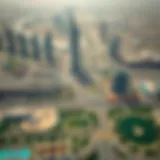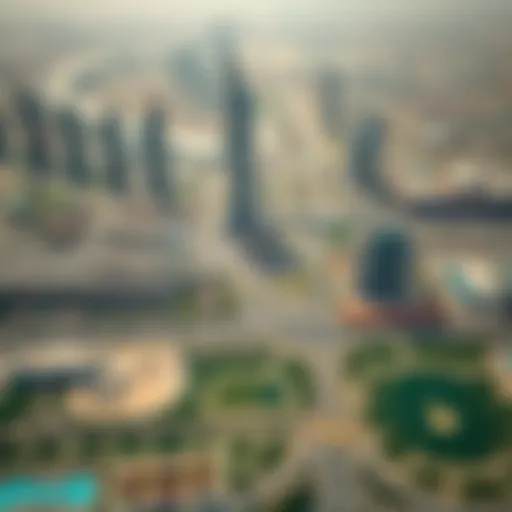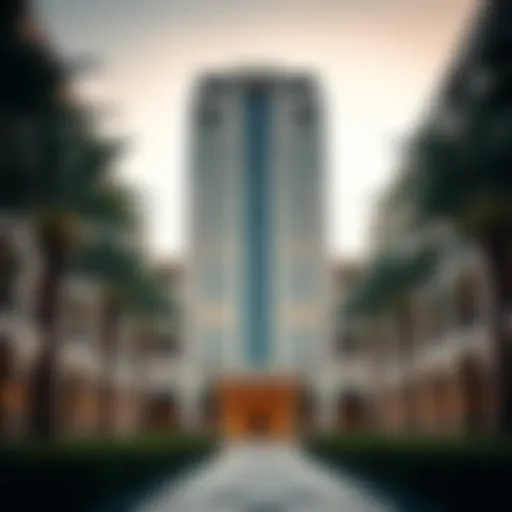Exploring Dubai's Metro Stations and Their Impact
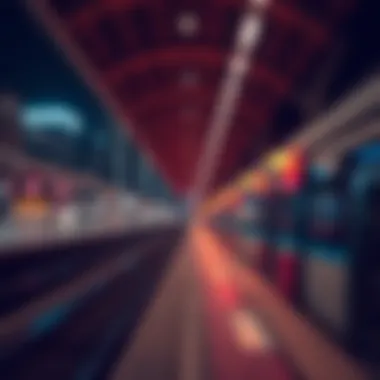

Intro
Navigating the bustling metropolis of Dubai without a proper understanding of its metro system is like trying to find a needle in a haystack. The metro stations are no mere transit points; they are lifelines intricately woven into the urban fabric of the city, shaping not just transportation but also influencing real estate trends, residential choices, and urban development. In this guide, we will explore the pivotal functionalities of these stations, the integral role they play in the expansion of this dynamic city, and insights crucial for homebuyers and investors alike.
As Dubai transforms into a global hub, understanding the functionality and significance of its metro stations becomes paramount. From connectivity to convenience, each metro station offers unique advantages, impacting lifestyle choices and economic landscapes. This investigation aims to unpack these themes, arming readers with knowledge needed to make informed decisions in the rapidly evolving real estate market.
Market Trends and Insights
Current Market Analysis
In recent years, the Dubai real estate market has witnessed a remarkable shift. The advent of metro stations has drastically changed property values in and around their vicinities. Properties located close to metro stations often command higher prices due to increased accessibility and the convenience they offer.
Areas like Dubai Marina and Downtown Dubai are prime examples, where proximity to metro stations leads to a surge of interest from both expatriates and investors. Commuters are now more inclined to pay a premium for properties that provide quick access to metro routes, reflecting a continued trend towards a car-free lifestyle.
Key factors influencing the current market include:
- The growing inclination towards public transport.
- Rising fuel prices, making commuting via metro an economical alternative.
- The government's investment in metro infrastructure, enhancing overall connectivity.
Future Predictions
The future looks promising for metro stations in Dubai. With plans for expansion and the operation of new lines, the reach of the metro system is set to increase substantially, consequently triggering an upward trajectory in property values.
Think of areas like Al Furjan and Dubai Investments Park, expected to benefit immensely from upcoming metro developments. Investors and homeowners seeking properties in these neighborhoods should brace for increased demand as the metro enhances accessibility.
The synergy between metro accessibility and real estate values is irrefutable; properties near metro lines become more attractive to buyers, contributing to the overall health of the real estate market.
Property Investment Strategies
Tips for First-Time Investors
Entering the property market in a city like Dubai can be daunting. However, understanding the metro's influence can provide significant advantages. For first-time investors, consider the following strategies:
- Look for off-plan developments nearing upcoming metro stations.
- Regularly assess market trends and prices in metro-adjacent areas.
- Engage with local agents who specialize in metro-linked properties, ensuring to tap into niche markets.
Understanding the Rental Market
The rental landscape in Dubai has adapted in tandem with the metro system, presenting numerous opportunities. Demand for rental properties near metro stations remains robust, especially among expatriates who prioritize accessibility.
Key insights include:
- Establishing competitive rental rates based on proximity to metro stations can maximize returns.
- Properties positioned within a short walking distance from stations are often in high demand.
- Consider amenities and services that appeal to commuters, such as furnished apartments or facilities for remote work.
In summary, knowledge of the metro system's layout and its associated benefits will serve as a valuable asset when navigating the property market in Dubai. This guide aims to provide clarity, helping potential buyers and investors leverage the metro stations' strategic importance for optimal real estate decisions.
For further information, you may refer to the unique insights on Dubai's Metro System or engage with community discussions on platforms like Reddit.
Understanding the Metro Network
Navigating through a bustling metropolis like Dubai requires more than just knowing where to go. The metro network stands as a critical backbone, intertwining the city’s vast areas and making commuting a seamless experience for both residents and visitors alike. More than an urban transport facility, the metro system significantly contributes to the urban planning landscape, impacting everything from real estate dynamics to daily traffic management. A deeper grasp of this network reveals its intricacies and the benefits it bestows upon its users.
Overview of Dubai's Metro System
Dubai's metro system, launched in 2009, is hailed as one of the most advanced and efficient transit systems in the region. Covering extensive routes across the city, it offers a safe and reliable means of transportation. The entire network is fully automated, featuring both the Red Line and the Green Line, each equipped with state-of-the-art facilities and punctuality that would make even a Swiss watch envious.
Key features of the metro system include:
- Automatic Train Operation: No drivers on board, reducing human error and improving safety.
- Air-Conditioned Trains: Keeping riders comfortable year-round, crucial in an arid climate like Dubai.
- Women and Children Only Carriages: Promoting safety and comfort for vulnerable passengers.
Such elements make the metro not just a mode of transportation, but a preferred choice for many.
History and Development
The path to constructing this metro system wasn't paved overnight. It represents years of planning, strategic foresight, and financial investment aimed at reducing the city's dependency on cars. Beginning in the early 2000s, various studies highlighted the need to alleviate traffic congestion and foster environmentally friendly commuting options.
By 2006, a massive investment of around $7.6 billion was dedicated to the project, leading to construction that employed approximately 40,000 workers. The metro's first operational line, the Red Line, became a reality in September 2009, a veiled testament to Dubai’s rapid growth and modern ambitions. Over time, the system evolved, with expansions indicating ongoing commitment to public transport. New lines have been added, enhancing accessibility and convenience.
Current Metro Lines and Stations
Dubai's metro features two primary lines: the Red Line and the Green Line, covering around 89 kilometers in total.
- Red Line: Extending from Rashidiya to UAE Exchange, it encompasses 29 stations. Key points of interest include stops close to significant developments such as the Burj Khalifa and Dubai Mall.
- Green Line: Running from Etisalat to Dubai Creek, connecting major neighborhoods including Al Nahda and Deira, it showcases the metro's role in bridging communities.


Station design varies significantly, highlighting cultural motifs and memorable aesthetics that contribute to the overall identity of Dubai. The metro stations are often equipped with amenities, including food outlets and shopping areas, making them more than just transit points but bustling hubs of activity.
"The metro not only provides a mode of transport but creates a vibrant urban environment around it."
Investors and homebuyers take note; proximity to metro stations often correlates with increased property values, underscoring the metro’s importance beyond mere commuting.
By understanding the metro network's complexity and enhancement over time, we can see how it plays a decisive role in shaping Dubai's urban landscape, paving the way for future growth and development.
Significance of Metro Stations in Urban Planning
Metro stations are more than just stops on a transportation route. They serve as pivotal elements in the urban fabric of a city, shaping development, mobility, and even lifestyle. In Dubai, a city that is constantly morphing under the pressures of both rapid growth and sustainability, the significance of the metro system cannot be understated. They create momentum for economic enhancement, precise traffic management, and a push toward a greener commuting future. Understanding these impacts is essential for homebuyers, investors, and urban planners alike.
Impact on Traffic Management
The effectiveness of a city’s transportation system plays a crucial role in reducing congestion and improving overall mobility. Metro stations in Dubai address this by providing an efficient alternative to road travel. In a city where traffic can rival the busiest urban centers in the world, metro stations serve as pressure valves, alleviating gridlock.
The metro's design encourages high-density commuting, drastically reducing the number of vehicles on the road. For instance, a single metro train can replace hundreds of cars, effectively lowering emissions and enhancing air quality. Ultimately, the more people utilize the metro, the less stress placed on road systems, which translates into smoother commutes.
- Improvement in Travel Times: Studies have shown that commuters can save a substantial amount of time using the metro compared to driving.
- Reduction in Traffic Jams: With trains running every few minutes, metro use helps minimize rush hour backups.
- Enhanced Public Safety: Fewer vehicles on the road lead to a lower accident rate, contributing to overall community safety.
Promotion of Sustainable Commuting
As cities across the globe grapple with sustainability, Dubai's metro stations represent a commitment to eco-friendly transportation. The very concept of a metro system aligns with sustainable development goals by offering a solution to the pitfalls of car dependency.
Riding the metro helps reduce the carbon footprint of daily commutes. Additionally, metro stations are accessible and designed with pedestrian-friendly surroundings, encouraging walking and cycling as part of the commuting process. Here, a few benefits can be emphasized:
- Decreased Emissions: Public transit emits fewer greenhouse gases per passenger compared to personal vehicles.
- Integration of Eco-technologies: Many stations incorporate solar panels and other green technologies, minimizing their environmental impact.
- Culture of Conservation: By using the metro, individuals contribute to a community ethos focused on sustainability and environmental stewardship.
Real Estate Development Around Stations
One cannot discuss the impact of metro stations without addressing their influence on real estate development. The proximity to a metro station significantly increases property desirability and value. Both commercial and residential areas have seen transformations due to this accessibility.
Investors and developers closely monitor station locations, often prioritizing developments that can benefit from station proximity. This results in a flurry of mixed-use developments, retail shops, and vibrant communities blossoming around stations. Some pertinent points are:
- Increased Property Values: Properties near metro stations often see higher appreciation rates compared to those farther away.
- Diverse Development Opportunities: Mixed-use developments enhance neighborhood vitality by incorporating residential spaces with commercial elements.
- Attractive to Expats and Locals: The convenience of nearby metro access makes these areas attractive to a wide range of prospective buyers and renters.
"Metro stations in Dubai serve as the heartbeat of urban transit, affecting not just mobility but shaping the entire cityscape."
In summary, the significance of metro stations in Dubai’s urban planning is multi-faceted. They enhance traffic management, promote sustainable commuting practices, and ignite real estate development, all while enriching the urban landscape. As the city continues to grow, the role of these stations will only become more pronounced, offering both challenges and opportunities for stakeholders in various sectors.
Key Metro Stations and Their Real Estate Implications
Understanding the various metro stations in Dubai provides crucial insights for stakeholders in real estate. Each station serves not just as a transit point but as a catalyst for urban growth and transformation. The strategic positioning of metro stations plays a pivotal role in shaping property values, driving development projects, and enhancing the overall livability of neighborhoods.
Dubai Marina Station
Real Estate Trends
Real estate trends around the Dubai Marina Station skew towards luxury apartments and expensive listings. This station attracts a mix of young professionals and affluent families, making it a hot bed for upscale living. The proximity to water and stunning views elevate its desirability, leading to significant price surges in properties. Key characteristics include high-end amenities and well-planned community spaces, which resonates with buyers looking for more than just a home; they desire a lifestyle.
- The rising rental yields around Dubai Marina emphasize its popularity for long-term and short-term investments.
- Unique features, such as access to entertainment hubs and proximity to the beach, set it apart from other areas. However, potential buyers may face challenges related to higher property prices and increased competition in the market.
Investment Opportunities
When discussing investment opportunities, Dubai Marina stands tall due to its consistent demand for both rental and sales. The area's growth has piqued the interest of seasoned investors seeking profitable prospects. Key traits include its potential for high returns, fueled by ongoing projects and the influx of tourism.
- Notably, developments like the Bluewaters Island project enhance the attractiveness of the area, pointing towards a bright investment prospect.
- The unique market dynamics allow for diverse investment options—from luxury condos to retail spaces—and can cater to varying budgets and investment strategies. However, high entry costs might deter some potential investors.
Residential Developments
Residential developments around Dubai Marina cater to a wealthy demographic, offering projects that include luxurious high-rises and serviced apartments. These developments typically have modern architecture and eco-friendly designs, which resonate with current trends in real estate favoring sustainability.
- The area has been a favorite among property developers, leading to continual new builds that provide fresh housing options.
- The high density of residential units means that buyers may encounter saturation in certain segments of the market, thus requiring astute financial planning and marketing strategies for developers.
Burj Khalifa/Dubai Mall Station
Property Valuation Insights
Property valuation insights from the Burj Khalifa/Dubai Mall Station are quite remarkable. As one of the most iconic landmarks globally, the area commands premium pricing, resulting in properties often valued higher than in other regions of Dubai. Key characteristics that drive this elevation in value interact with global tourism and business activities.
- The proximity to world-class attractions boosts the real estate market and brings a steady flow of potential buyers.
- Unique features such as luxury malls and dining establishments translate to higher foot traffic, making it a hot spot for investors. Yet, buyers should be aware of fluctuating market conditions that could affect long-term value retention.
Commercial Real Estate Impact
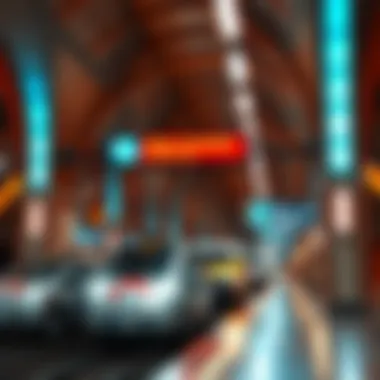

The commercial real estate landscape around the Burj Khalifa and Dubai Mall is vibrant and filled with opportunities. The buzz of business is palpable and attracts big-name retailers and global brands. Key characteristics include high visibility and prime foot traffic, which make it a prime location for companies.
- Significant growth in commercial properties signifies an ongoing vibrancy that attracts innovation hubs and co-working spaces.
- While demand remains strong, potential investors need to recognize the fierce competition for commercial spaces that can raise operational challenges.
Luxury Segment Growth
The luxurious development around the Burj Khalifa/Dubai Mall continues to witness significant growth. The ongoing demand for upscale living contrasts starkly with other regions of Dubai. Key traits include high-end amenities, desirable location, and bespoke customer service.
- Developments include exclusive residential towers and premium retail space elevating the status of the area further.
- Yet, high construction costs and potential oversaturation could pose risks for new developments in this segment.
Deira City Centre Station
Mixed-Use Developments
Mixed-use developments in the vicinity of Deira City Centre are becoming increasingly popular due to their convenience and multifunctionality. By combining residential units, retail spaces, and office areas, these developments cater to the evolving lifestyle choices of urban dwellers. Key characteristics include the integration of amenities that simplify daily life, appealing particularly to families and young professionals.
- These developments often foster a sense of community and boost local economies.
- However, coordinating various functions within these spaces can sometimes lead to logistical challenges and community management issues.
Retail and Commercial Prospects
The retail and commercial prospects around Deira City Centre Station are extensive and play a significant role in revitalizing the area. With an established shopping mall nearby, the demand for retail spaces remains unwavering. Key traits include access to public transport and an ever-growing population base.
- The presence of a mix of international and local brands feeds consumer interest and supports sales growth in the area.
- However, tenants must remain mindful of the seasonal fluctuations in foot traffic that could affect business performance.
Neighborhood Analysis
Neighborhood analysis near Deira City Centre reveals a historically rich area with a blend of traditional and modern elements. The gradual embrace of modern life is obvious, driven by new developments and a multicultural environment. Characteristics include diverse dining options, cultural landmarks, and vibrant street life.
- Families appreciate the availability of schools, parks, and healthcare facilities, underpinning the area’s appeal to homebuyers.
- Yet, the balance between maintaining cultural heritage and accommodating new developments poses a challenge that requires thoughtful planning.
Navigating the Metro System
Navigating the metro system in Dubai is a crucial aspect that reflects the efficiency and interconnectedness of urban travel. Understanding how to effectively use this network not only enhances the commuting experience but also provides significant insights for homebuyers, investors, and residents alike. With its well-planned routes and user-friendly operations, the metro system is designed to seamlessly integrate into Dubai's dynamic urban landscape, offering considerable benefits for those who choose to rely on it.
Metro Etiquette
Metro etiquette is an important consideration for anyone using Dubai's public transportation system. Simple courtesies go a long way in making the commute pleasant for everyone. For instance, it is common practice to give priority seats to the elderly and those with disabilities, as well as to refrain from loud conversations. In addition, travelers are encouraged to keep the metro clean and dispose of any trash appropriately. Respecting personal space is another crucial aspect; the metro trains can get crowded, especially during peak hours, so keeping a polite distance can make the journey much more bearable for all involved.
A few tips for metro etiquette include:
- Stand clear of the doors: Allow people to exit before you board.
- Keep noise levels low: Use headphones for devices, and avoid phone calls.
- Respect queue formation: Wait your turn in the line to board and deboard.
Establishing a culture of respect not only enhances daily commuting but also contributes to the overall positive atmosphere within the metro system.
Accessibility Features
Accessibility features in Dubai's metro system highlight the city’s commitment to inclusivity. The metro stations are designed to accommodate individuals with disabilities or those who may have difficulty navigating stairs or uneven surfaces. Elevators, ramps, and designated seating areas ensure that everyone can enjoy the benefits of the metro.
In addition to physical accessibility, the trains themselves are equipped with auditory and visual announcements, making it easier for visually impaired or hard-of-hearing passengers to understand their stops. The careful attention to these features indicates that the metro system not only aims to be efficient but also strives to be a welcoming space for all travelers.
Key accessibility features include:
- Wheelchair ramps at station entrances and exits.
- Designated seating for individuals with mobility challenges.
- Braille signage throughout stations and in trains.
These elements enhance the overall user experience, ensuring that the metro system remains a reliable option for all individuals navigating Dubai’s vibrant urban sprawl.
Ticketing and Fares
Understanding ticketing and fares is essential for anyone planning to use Dubai's metro system. The fare structure is thoughtfully designed, making it economical for regular users yet accessible to occasional travelers. Fares are determined by the distance traveled, meaning greater transparency and fairness in pricing.
Purchasing a ticket is straightforward. Travelers can use ticket vending machines located at each station, offering multiple languages for ease of use. Additionally, the NOL card provides a convenient option for frequent travelers, allowing for seamless travel across various transport modes without needing to buy a new ticket each time.
Important points regarding ticketing include:
- Prices vary based on zones crossed during travel, with options for single journeys or multiple rides.
- NOL cards can be recharged at stations or through dedicated machines, promoting a hassle-free experience.
- Discounts are available for students and senior citizens, enhancing affordability.
By understanding how fares work, passengers can better plan their trips and manage their commuter budgets. In the grand scheme, efficient ticketing contributes not only to a smoother journey but also to the increase of metro usage among both locals and visitors.
Navigating the metro system is more than just a means of transportation; it's a reflection of the urban fabric of Dubai and the lifestyle choices of its residents.
The Future of Metro Expansion
The expansion of Dubai's metro system is not just about adding more trains and tracks; it's a crucial stepping stone toward a smarter, more connected urban landscape. As this city evolves, the metro is set to play an even more significant role in easing congestion, enhancing accessibility, and promoting sustainable lifestyles. Here, we’ll explore upcoming projects, their potential routes, and the technological advances that promise to reshape the commuting experience in Dubai.
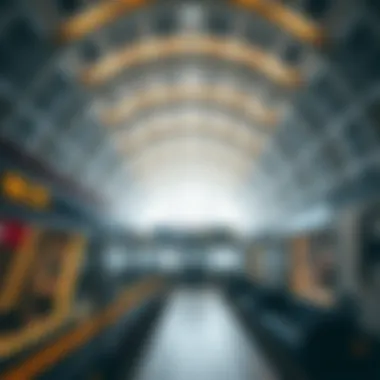

Upcoming Projects
New Stations Planned
With the increasing demand for reliable public transport, new stations planned come as a breath of fresh air. One of the standout characteristics of these proposed stations is their strategic locations. They aim to connect key areas that are currently underserved by the existing metro lines. For instance, connecting the suburbs to the business hubs will facilitate easier access for commuters and encourage the use of public transport over personal vehicles.
A unique feature of these upcoming stations is their design, which often harmonizes with local architectural styles, reflecting the cultural essence of Dubai. While the benefits include improved access and stimulated local economies, one need to be mindful of the disruption during construction.
Extended Routes
Extended routes promise to broaden the reach of the metro system, allowing it to cover areas that are growing at a remarkable rate. This key characteristic enhances the user convenience massively. The planned extensions will especially benefit regions such as Dubai Investment Park and other developing zones, making commuting feasible for more residents.
What sets these routes apart is their potential integration with future projects, creating a seamless commuting experience. Notably, while increased accessibility is undoubtedly a plus, the potential for over-crowding in some areas will require careful management.
Technological Advancements
The future cannot be discussed without considering technological advancements. Integrating cutting-edge technology into the metro system is not merely beneficial; it's essential for keeping pace with global standards. Features such as automated ticketing systems and real-time updates for commuters are on the horizon.
One significant aspect of these advancements is their focus on sustainability, with plans to incorporate energy-efficient systems. However, while these tech-forward solutions may enhance user experience, they come with the challenge of implementation costs and training staff to adapt to new systems.
Integration with Other Transport Systems
Fluent integration with other modes of transportation is vital for maximizing the efficiency of the metro system. Integration with other transport systems like buses, taxis, and bikes enables a holistic transport network that can reduce reliance on private vehicles even further.
Moreover, it facilitates the seamless movement of people across different zones, encouraging them to embrace public transport. A noteworthy characteristic here is the development of dedicated hubs that would allow easy transfers between different transport modes.
Successful integration depends on careful urban planning and the input from various stakeholders, ranging from government authorities to local communities. Without a doubt, this aspect of the future metro expansion has the potential to make a significant impact on streamlining commutes and enhancing urban mobility.
Metro Stations and Community Development
The role of metro stations in fostering community development cannot be overstated. Metro stations do more than facilitate transportation; they act as catalysts for social interaction, economic growth, and urban revitalization. Their strategic locations promote accessibility, which is essential for improving the quality of life for residents and visitors alike.
Key to urban planning, metro stations contribute to a more interconnected city, reducing reliance on private vehicles and lowering traffic congestion. The undeniable importance of these hubs lies in their ability to blend transit access with community-driven initiatives that uplift local neighborhoods. Understanding how metro stations can enhance community life is crucial for homebuyers, investors, and urban planners.
Encouraging Transit-Oriented Development
Transit-oriented development (TOD) is a planning approach that emphasizes the importance of public transport as a basis for community growth. By centering developments around metro stations, urban planners can create vibrant hubs that promote walkability and accessibility. This model not only facilitates easy commuting but encourages a sustainable lifestyle, as residents can rely on public transport instead of cars.
Examples of transit-oriented projects around Dubai metro stations include the various residential and mixed-use properties that have sprouted in areas like Jumeirah Lakes Towers and Dubai Marina. These developments provide an array of amenities designed to meet residents’ needs while enhancing overall convenience. In turn, they contribute to a lively community atmosphere, where people engage in social activities right at their doorstep.
Enhancing Local Economies
One of the most significant impacts of metro stations is their ability to invigorate local economies. When a metro station is established, businesses in the surrounding area often see a spike in customer traffic, boosting sales and attracting new vendors. This influx creates job opportunities and fosters entrepreneurial innovations, as new companies spring up to cater to the increased foot traffic.
Additionally, property values around metro stations tend to rise, encouraging investment in the local real estate market. From quaint cafés to high-end retail shops, the ecosystem surrounding these stations thrives, creating a momentum of economic growth and vitality. Metro stations are conduits for community commerce, bridging the gap between consumers and retailers.
Community Spaces Around Stations
Creating inviting community spaces around metro stations is another aspect that offers numerous benefits. Parks, plazas, and cultural centers situated near public transport hubs enhance the attractiveness of neighborhoods. They serve as gathering places for residents, promoting social interaction and community solidarity.
Designing spaces that integrate nature, art, and gathering spots can lead to more vibrant communities where people want to live, work, and play. Engaging local artists to contribute to installations or programming events in these spaces can help build community identity. Such initiatives bolster the sense of belonging, ensuring that metro stations contribute not only as transit points but also as anchors of community life.
For more information about urban development strategies, visit Wikipedia or refer to resources like Britannica for deeper insights into this topic.
Comparative Analysis: Metro Systems Worldwide
Analyzing metro systems across the globe reveals not only the diversity in urban transit solutions but also highlights how different cities tackle similar challenges. This comparative examination offers insights into effective practices that can be adapted to enhance Dubai's already impressive metro network. Understanding these various systems can help urban planners, investors, and residents appreciate the broader context of transit infrastructure, which, in turn, can inform future improvements and expansions.
Metro systems are more than just lines on a map; they are lifelines that connect communities, facilitate economic growth, and influence urban design. By looking at what has worked elsewhere, Dubai can continue to innovate while addressing local needs. There’s a lot to learn from successful metropolitan transit systems, and this section explores these best practices and what lessons can be drawn for the future of Dubai Metro.
Global Best Practices in Metro Transit
Certain cities exemplify the successful integration of metro systems into their urban fabric, enhancing both commuter experience and operational efficiency. Here are some best practices observed in global metro systems:
- Safety and Security Measures: Cities like Tokyo have stringent protocols around passenger safety. Their robust security measures, including surveillance and real-time monitoring, ensure a secure transit experience.
- User-Centric Design: The Paris Metro is renowned for its intuitive layout and effective signage that cater to both locals and visitors. This user-friendly approach minimizes confusion and enhances overall satisfaction.
- Technology Integration: The implementation of smart ticketing systems in cities like Seoul streamlines payment processes, reducing wait times and improving rider convenience. Dubai could enhance its existing ticketing options with more tech-driven solutions.
- Sustainability Focus: Cities such as Copenhagen are capitalizing on eco-friendly transit options, encouraging the use of bicycles alongside metro services. Creating connections between bike lanes and metro stations can promote a more sustainable commuting culture.
- Flexible Operations: The New York City Subway showcases adaptability with extensive service hours. Providing extended operating hours can draw in more ridership and improve accessibility.
Adopting these best practices may lead to enhanced efficiency for Dubai's metro system while ensuring it meets the needs of a rapidly growing population.
Lessons for Dubai's Metro Future
As Dubai strives to position itself as a global hub, the insights gleaned from a comparative analysis of world metro systems can pave the way for a successful future. Here are some lessons that can be effectively implemented:
- Invest in Expansion and Integration: Continued investment in expanding the metro lines and integrating them with other modes of transport can create a more seamless transition for riders. Having well-connected metro stations that link with buses, trams, and even water taxis will encourage more people to utilize public transit.
- Focus on Multimodal Connectivity: Encroaching on the strengths of integrated transport systems abroad can inform Dubai Metro's planning. Promoting connections with taxis and rideshare services can cater to last-mile connectivity needs.
- Enhance the Passenger Experience: Cultivating a positive experience through cleanliness, customer service training, and engaging amenities can encourage more residents and tourists to opt for the metro. Small changes can make significant impacts on how the system is perceived.
"Creating a commendable user experience can turn peak-time travelers into regular commuters."
- Adopt Smart Technologies: Encouraging the embrace of smart urban technologies, such as mobile applications for real-time updates or service alerts, positions the metro as a modern choice for tech-savvy riders.
- Promote Community Engagement: Learning from cities with successful transit hubs, such as Barcelona, nurturing community events around metro stations can enhance local engagement and further integrate the transit system into the societal fabric.
As Dubai looks to expand its metro system, applying such lessons from successful global practices not only enhances operational effectiveness but also boosts commuter satisfaction, thus ensuring that the metro system evolves with the needs of the city.
